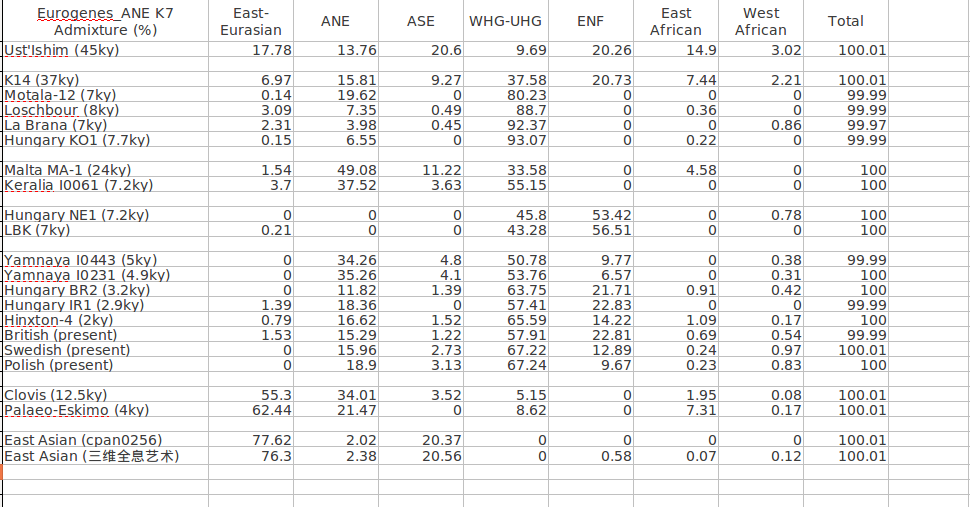wegene數據與古人類DNA的對比
對比自己的wegene數據與古人類DNA的意義重大。如果您已經的有了原始數據,請上載到GEDmatch(www.gedmatch.com),wegene數據需要先壓縮成zip文件。然后在Analyze Your Data->DNA raw data->Admixture (heritage)->Eurogenes->選擇Admixture Proportions (With link to Oracle),即可得到您的ANE_K7計算結果。相關的古人類DNA的ANE_k7詳細對比請見http://ranhaer.s47-56.myverydz.com/thread-30817-1-1.html?
請大家分享對比結果,我的結果是圖中的三維全息藝術。
?
請大家分享對比結果,我的結果是圖中的三維全息藝術。
?



12 個回復
贊同來自: ASDQZXknbvf
贊同來自:
贊同來自:
1、既然是祖源,“祖”到什么程度,必然有個時間尺度,現代人群基本都是在新石器時期開始形成的,重點必然放在這個時間段內;當然上推到萬年前,可以用來分析更早的人類演化情況,例如其他古人類與現代智人的融合情況、現代智人的遷徙情況等,但沒有新石器古DNA來的直接。
2、漢族前身華夏族的形成時間,目前廣為接受的說法于3000~4000年前開始、秦漢時基本形成,用這個時間段的古DNA是最能說明問題的,因為是實打實的材料,但各祖先人群的時間應該大致統一,或者有證據表明前后沒有太多變化;其他民族的形成時間更短,分析情況同理,但時間上就長不就短、也可以用這個時間段的古DNA。
3、關于祖先人群的選擇:
(1)原始漢藏人群肯定是現代漢族的重要源頭之一,這個從語言和Y都有很多證據,而到了3000年,原始漢藏人群應該已經分化了,至于超哥所說的3000年前的古藏人,不知道是否指尼泊爾chokhopani的那例,藏族祖先已經進入高原腹地并很可能與當地的土著發生了融合或經歷了強烈的自然選擇或經歷瓶頸發生漂變,所以以此來代表分化后的華夏族祖先成分,可能會有些問題吧,但目前沒有3000年左右確實的原始漢藏分化后形成的華夏族祖先方面的古DNA(渭水中上游、隴東、陜北一帶),也是聊勝于無,或許可以結合其他例如高原適應方面的數據、admixture分析來剔除相關成分?
(2)期待同期商人或更早期的中國東南西北中古DNA
贊同來自:
那兩位怎么看待這兩幅圖中的TB和CHB(或者說N-Han)的關系:
http://www.plosgenetics.org/article/info%3Adoi%2F10.1371%2Fjournal.pgen.1001116?
http://www.plosone.org/article/info:doi/10.1371/journal.pone.0017002
?
>>PloSOne這篇很明顯啊漢藏緊密聚類,說明漢藏遺傳近緣。
@wang 那王兄怎么解釋第二幅圖中Tibetan跟Northern Chinese比Yi(彝)和Lahu(拉祜。體質分類上屬典型南亞類型)甚至Cambodian跟Northern Chinese還遠?
贊同來自:
贊同來自:
贊同來自:
?
Reconstructing population history in East Asia
Chuan-Chao Wang1 ,3, Nadin Rohland1, Shop Mallick1, Longli Kang6, Shi Yan2, Rukesh Shrestha2,
Shaoqing Wen2, Oleg Balanovsky5, Elena Balanovska5, Yuri Bogunov5, Qiongying Deng7, Hongbing
Yao8, Kumarasamy Thangaraj10, Lalji Singh10, Rong Lin9, Wangwei Cai9, Dongna Li9, Ling-Xiang Wang2,
Manfei Zhang2, Lan-Hai Wei2, Alexander Kim1, Pontus Skoglund1, Iosif Lazaridis1, Iain Mathieson1,
Stephan Schiffels3, Wolfgang Haak3, Chris Stringer11, Nick Patterson1, Li Jin2, Alexander N Popov4, Hui
Li2, Johannes Krause3, David Reich1
1 Department of Genetics, Harvard Medical School, Boston, Massachusetts, USA,?
2 MOE Key?Laboratory of Contemporary Anthropology, School of Life Sciences, Fudan University, Shanghai,
China,?
3 Department of Archaeogenetics, Max Planck Institute for the Science of Human History, Jena,?Germany,?
4 Scientific Museum, Fareastern Federal University, Vladivostok, Russia,?
5 Vavilov Institute of?General Genetics and Research Centre for Medical Genetics, Russian Academy of Sciences, Moscow,?Russia,?
6 Key Laboratory of High Altitude Environment and Gene Related to Disease of Tibet, Ministry
of Education, Tibet University for Nationalities, Xianyang, Shaanxi, China,?
7 Department of Anatomy,Guangxi Medical University, Nanning, Guangxi, China,?
8 Key Laboratory of Evidence Science of Gansu?Province, Gansu Institute of Political Science and Law, Lanzhou, Gansu, China,?
9 Department of?Biology, Hainan Medical College, Haikou, Hainan, China,?
10 Centre for Cellular and Molecular Biology,Hyderabad, India,?
11 Department of Earth Sciences, The Natural History Museum, London, UK
The deep population history of East Asia remains poorly understood compared to that of West Eurasia,
due to the lack of ancient DNA data as well as limited sampling of present-day populations especially
on the Tibetan Plateau and in southern China. We report a fine scale survey of East Asian history based
on genome-wide data from ancient samples in the Amur River Basin, as well as 435 newly reported
individuals from 53 populations. Present-day groups can be broadly classified into highly
differentiated clusters, corresponding to Amur River Basin, Tibetan Plateau, southern natives and Han
Chinese. Populations of the Amur River Basin show a high degree of genetic continuity from seven
thousand years ago until today, and are closely related to the strain of East Asian related ancestry
present in Native Americans. Tibetan Plateau populations are all admixed, deriving about 5%-10% of
their ancestry from an anciently divergent population that plausibly corresponds to the Paleolithic
population on the Plateau, and the remaining part from an ancient population that no longer exists in
unmixed form but that likely corresponds to expanding farmers from the Middle and Upper Yellow
River Basin who also contributed 40-90% of the ancestry of Han Chinese. A total of 10-60% of Han
Chinese ancestry derives from southern Native populations, and we show that the type of southern
Native ancestry that contributed to Taiwan Island Austronesian speakers is most closely related to
present-day speakers of Tai-Kadai languages in southern mainland China.
贊同來自: 費力科思
贊同來自:
贊同來自: 藍星旗 、田園牧歌 、blackman6688 、黃隆思 、jianjinhanzhi 、墨存更多 ?
?
Ancestral South Eurasian (ASE): this is a really basal cluster that peaks in tribal groups of Southeast Asia. It's probably very similar in some ways to the Ancestral South Indian (ASI) component described by Reich et al. a few years ago.
贊同來自: 田園牧歌
要回復問題請先登錄或注冊